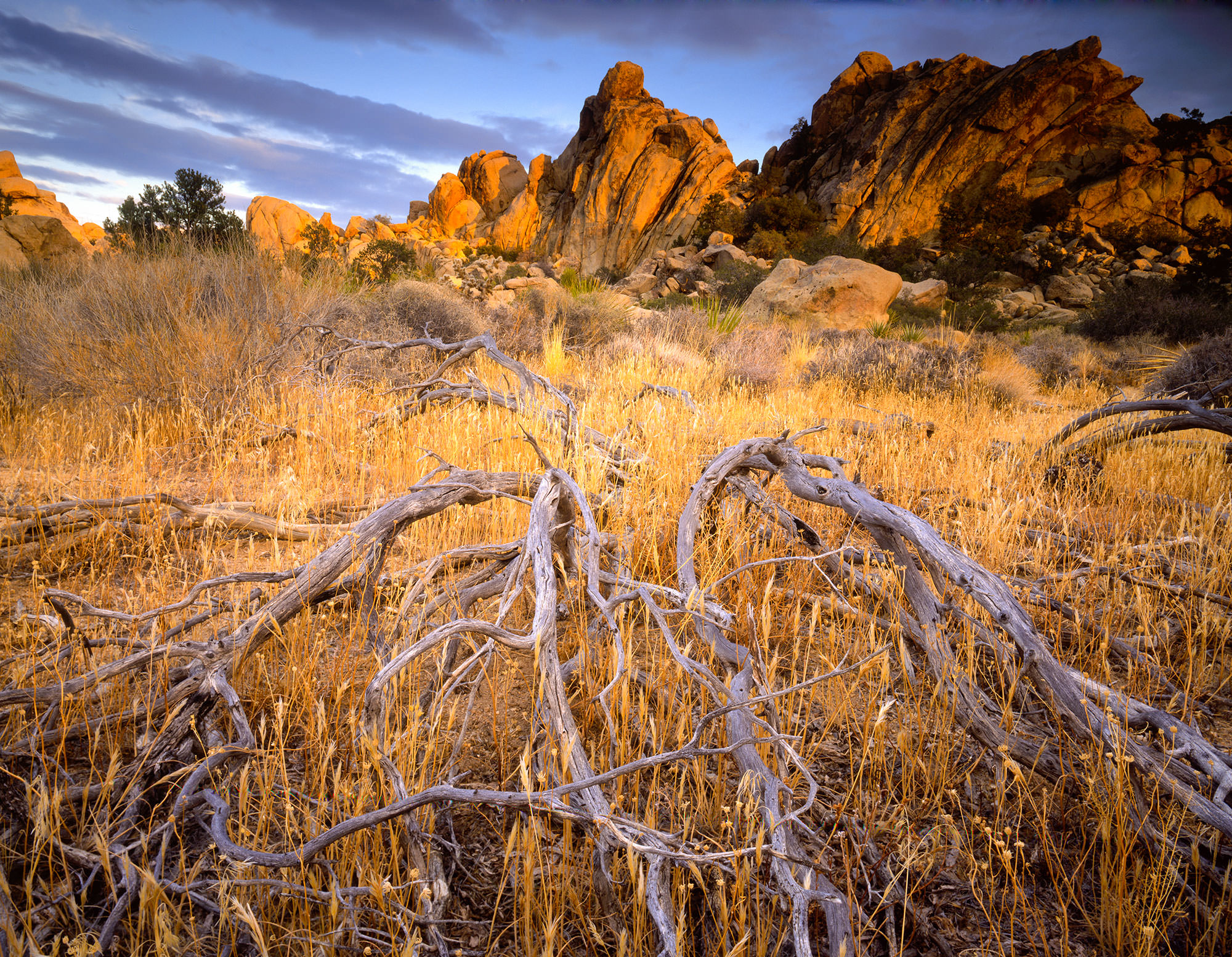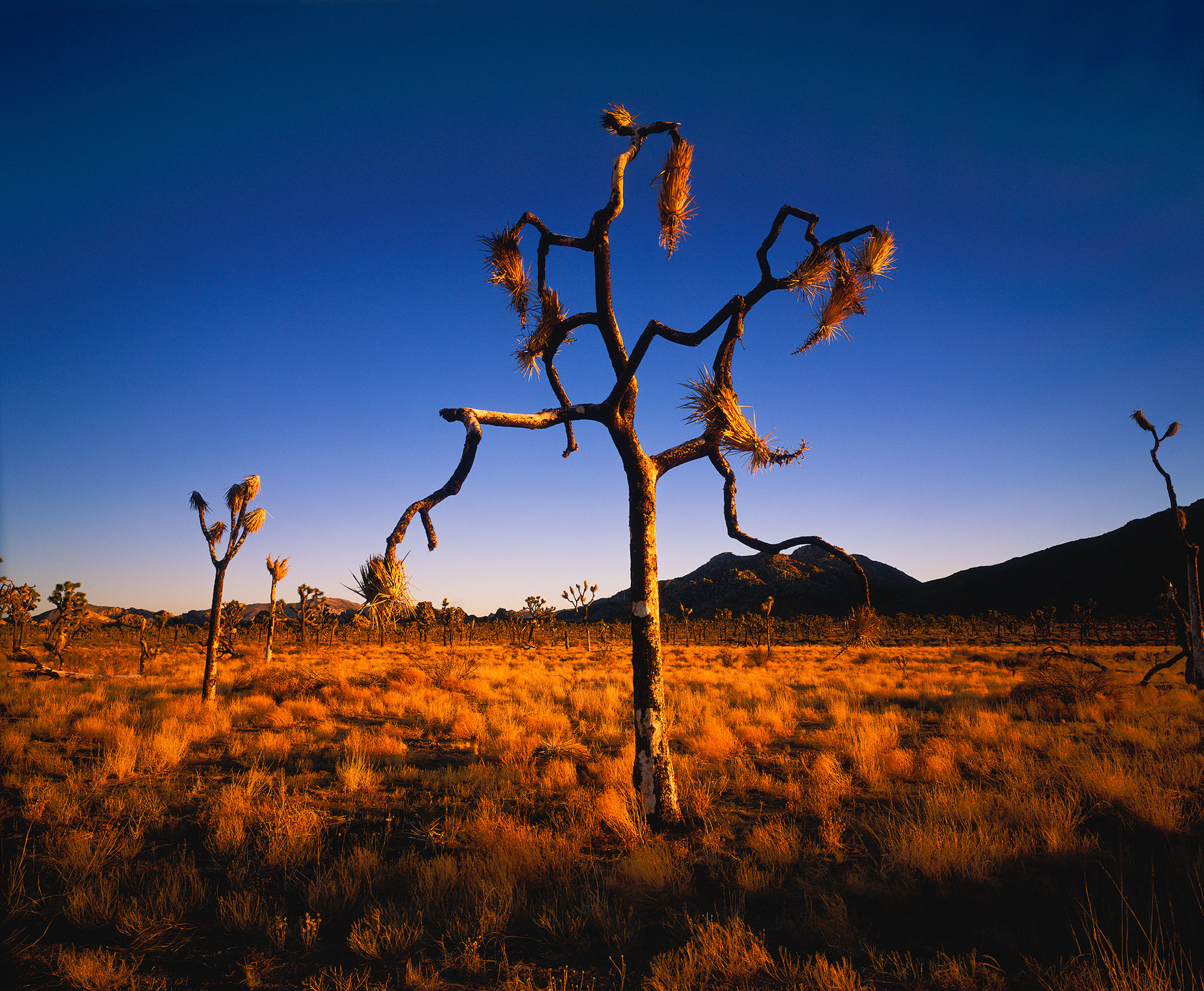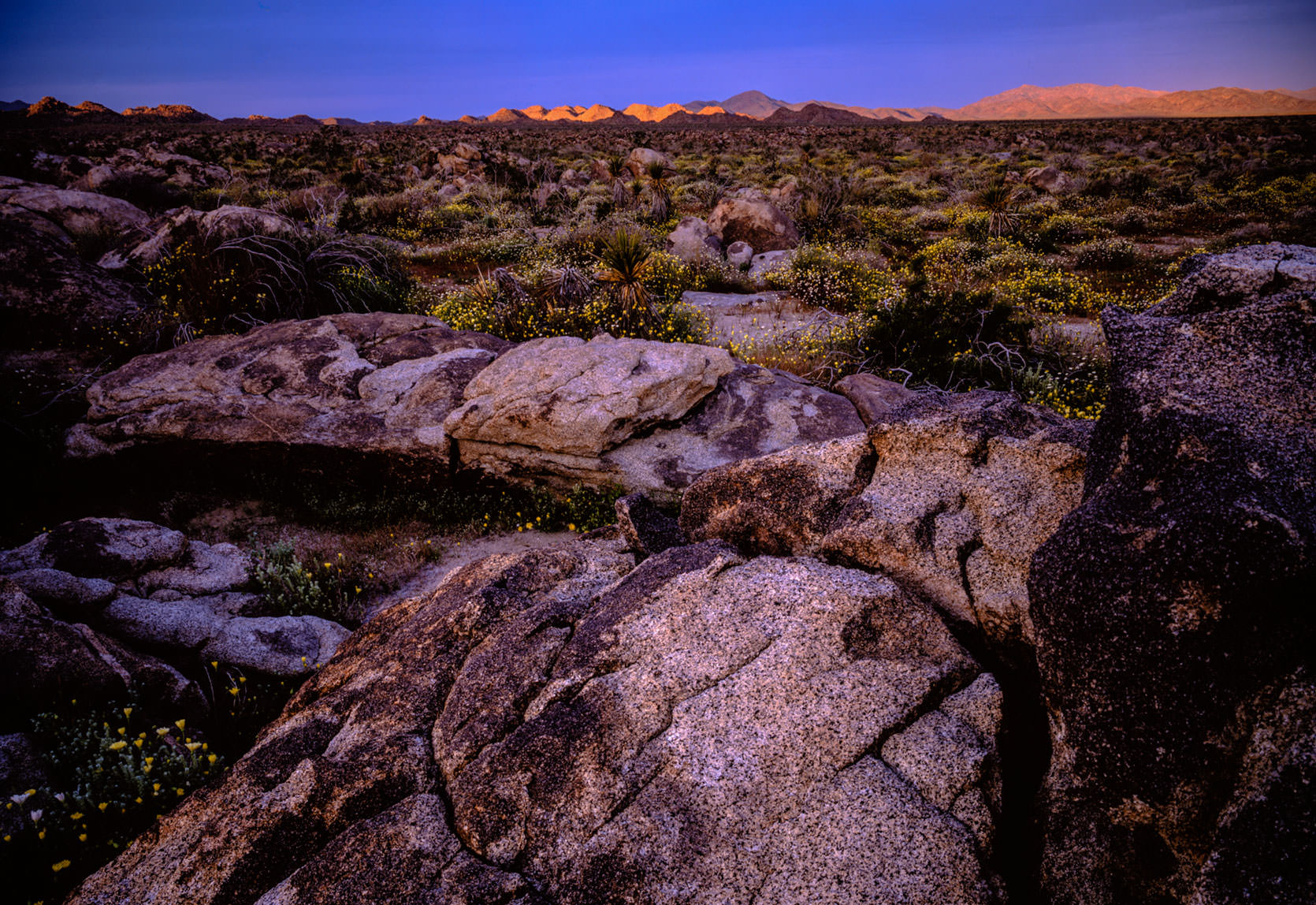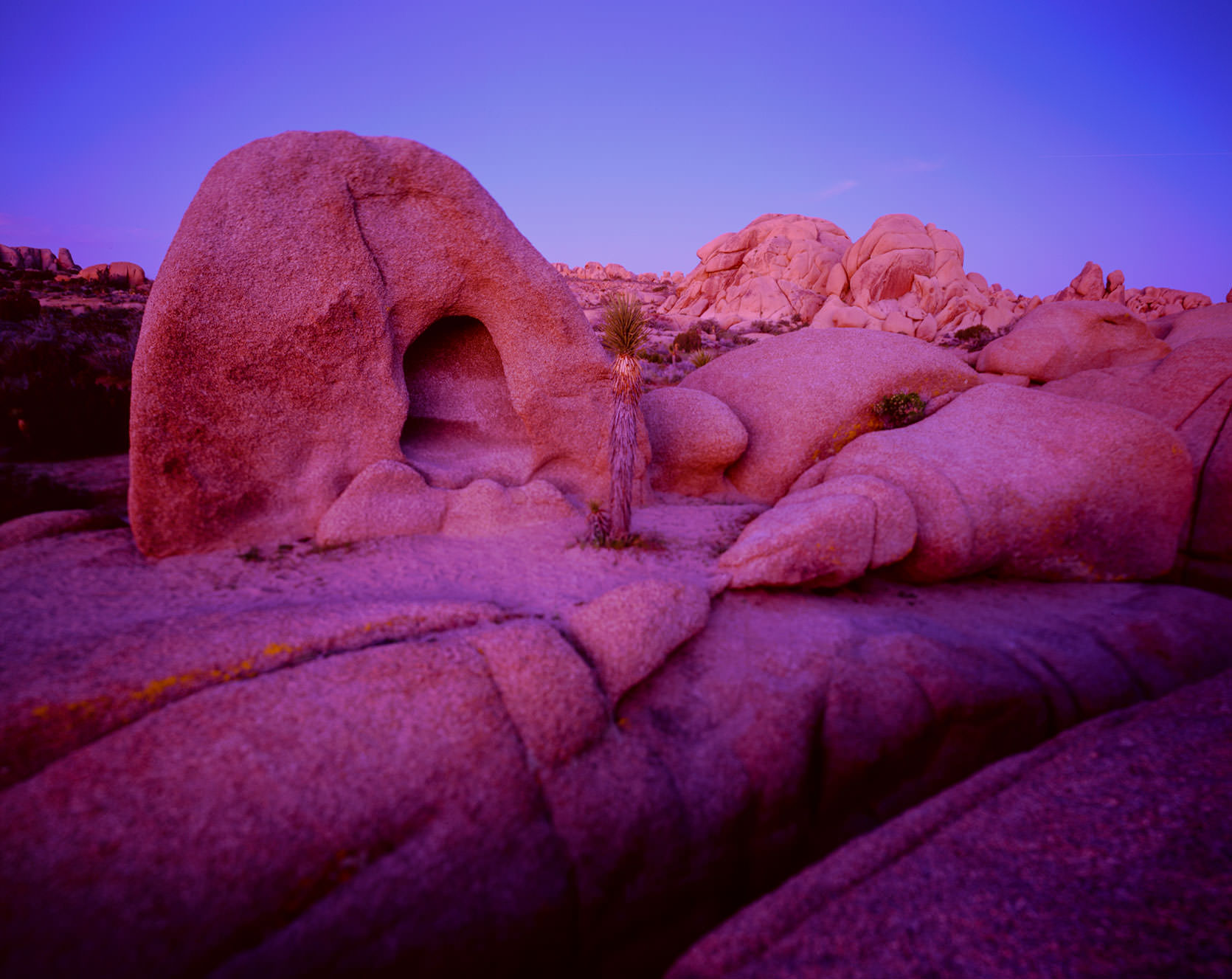Desert Southwest

Four Seasons of the Western Mojave
Road trip notes from Joshua Tree National Park and the Western Mojave of Southern California.
W
e drove down Grand Avenue on Bunker Hill in downtown Los Angeles. Just a week before, it was reported that a new fault line crossed directly below. I suspect this news to have little impact on the city.
We drove under a movie set; the same sterile gray and silver stretch filmed in the movie Heat. We left for LaVerne. People here wear plaid; and at the lunchtable across from us, a group of fortysomethings talked art and science. A sign that we are no longer in L.A. In a few hours, we were in the Mojave; Joshua Tree National Park.
We played Vivaldi's "The Four Seasons." Perhaps this was innapropriate. There are no seasons here. In fact, nothing seems to ever change in Joshua Tree. Everything here has the feeling of a lost relic from the prehistoric. Granite monoliths piled awkwardly, every plant gnarled or brown. In the case of the Mojave Yucca, or its cousin, the Joshua Tree, perennially green, but twisted and contorted and cartoonish. Dr. Suess has gone mad.
But the feeling that nothing has changed here is hardly true. Thousands of years before, people crossed from Mongolia into Alaska and settled here as the Pinto, collecting pinyon nuts along a gently flowing desert river. Before that, elephants crossed this range and reportedly swam the Pacific to Asia. Mammoths died among these rocks, and before that, dinosaurs and lizards ate along the Colorado River which at that time flowed nearby.

Dead Joshua Trees in Joshua Tree National Park.
Before that, all this land was under some other layer of sediment; magma formed bubbles and odd shapes under ground and froze into granite. Time shifted the top-layers away and left these strange structures beaming in the wind. The feeling that I get of unchanging land is, I recognize, nearsighted.
As a species, we tend to see history in terms of 5 generations, with a heavy concentration on the one in the middle. But if you take the story of creation as a parable for the history of the world - Monday and Tuesday are what God used up to get the world going. Life began Tuesday, around noon.
The anarchic beauty of it all unfolded over the next four days. At one-fortieth of a second before midnight, the industrial revolution began. So quick to elect ourselves God's rightful heir and master of all living creatures; it's strange how we view our existence as a natural establishment of Darwin's theorums. In fact, there have been five major extinctions over the course of the world; each on average destroying 20 percent of all species.
But these occurred over thousands or millions of years; where in the sixth, in just that last 1/40 of a second, man has doubled the size of the Sahara, and brought South American rainforests to six percent of their original size. We consume nearly half the world's biological production and over half of all available freshwater. Species, in fact, are dying between a hundred to a thousand times faster than normal. A little respect for God's creation, some common sense and some sound economics can reverse all this.

But that's a story for another time and place; for we are leaving the Prehistoric Mojave for the rugged desolation of the Colorado Desert; a subset of the Sonoran, and a very hot, dry and unforgiving place.
We end up in a quarter square mile garden of cholla an hour before sunset. Last time I was to photograph these cholla, my equipment failed in the heat. This time, my equipment is mechanical.
Setting up among the cactus, a cholla barrel lodges itself in my leg. Cholla spines are an inch and a half of the sharpest plant in the world; Lily's cholla injury from last year still hasn't healed. I remove twenty spines from my leg with a pliers and in vengeance I kick another barrel as hard as I can with impenetrable waterproof boots - the barrel goes nowhere except through my boot; 20 spines in my big toe and the arch of my foot. I may do stupid things in life. But in Joshua Tree I excel at it. Last year, I left my camera bag, and everything in it - off a stretch of road 20 miles from any significant marking. "Where did you leave it?" the ranger asked.
"Between West Entrance and Quail Springs."
"Which side of the road?"
"I don't remember."
Two weeks later, it was found.
With all the pain and blood and unremoved spines, I looked up at the sun - 10 minutes until my shot. So I hobbled to my film bag; another cactus barrel. Anything for this shot - I wasn t going to miss it again. I open the bag - the film was not loaded.
Good god I never loaded my film. It would take 10 minutes to load 4 sheets of film. I sat down, and in eight minutes three were loaded. Stood up. Hobbled to the camera. Shoved the film in, and just then, the sun went down, and the majesty of the Sonoran faded.
Next time.

Jumbo Rocks area, Joshua Tree National Park
At five in the morning we were racing across the desert to Hidden Valley. The white sands of Joshua are purple in pre-dawn; the trees arch and hang over the road, and become visible one by one, twisted and wrathlike; straight out of Sleepy Hollow or Stephen King. We pull up along the road, and I walk underneath boulders, and through them, and eventually, on top of them.
From here I can see five miles of trees, and a Jack Rabbit, the size of a small dog ditching his Chuparosa hideout. I find a Prickly Pear Cactus, and examine some lichen through my loupe - lime, aqua, red-orange and pitch. When dawn broke, we walked through Hidden Valley, a windless, completely rock enclosed valley.
A coyote had been following us.
I heard him, but couldn t see him. When Lily sat down for water, he made himself known beside a creosote - he was the most vividly rust Mexican wolf I have ever seen, beautiful and not emaciated like the ones who sit by the road waiting for some French tourists to throw them some bread. Lily never seems to be bothered by large mammals.
I urged us to keep distance, and soon, we were driving in the remotest of the Joshua Tree National Park roads, along Geology Tour and Lost Horse Mining Trail and up to Keyes View, a sight of 29 Palms and the Air Force Installation behind the next mountain range. We identified new species: desert mallow, death cactus, lupine and silver cholla. French bread. Gouda. Water. And we were on our way back to Los Angeles.
Explore more in the Desert Southwest
Waves of Sand in Rainbow Country
While hiking in the Vermilion Cliffs, I dive into the ancient geological epochs that created these rainbows of stone
The Road to Quitobaquito Springs
On the Road to a small desert spring, I investigate the border wall and the case for resurrecting a Transboundary Preserve.
Cactuses of the Desert Southwest
My ongoing project to sketch every cactus in the Desert Southwest and the United States.
Mud Road to Coyote Buttes
Notes on traveling to the Coyote Buttes during surreal winter weather.
Atomic Agriculture on the Rio Grande
Road trip to the Hatch Chili Festival in Southern New Mexico.
Bombay Beach and the Salton Sea
Kayaking the Salton Sea to the tiny seaside town.
Paddling and Driving the Los Angeles River
Exploring the LA River by road and kayak, with notes on my 14 years living in the city.
Death and Salvation on the New River
Notes on ecological devastation and salvation along the New River in Southern California.
Barren Anza Borrego Desert
Notes on the rich desert tapestry of Anza-Borrego in Southern California.
Panamint Valley Roach Motel
You want to hear about a hotel nightmare? Notes from Panamint Valley, California.
Four Seasons of the Western Mojave
Notes on my travels to Joshua Tree National Park and the Western Mojave of Southern California.
Trona and the Unusual Lake Searles
Notes from a desert California outpost, and the weird rocky world of the Searles lakebed.
Reefs of Pollen on the Carrizo Plain
Exploring the idea of travel and limitations during some of the amazing wildflower blooms in California history.
Longboarding Las Vegas
A few years ago, I decided to cross Las Vegas by skateboard, and then write about it.
Valley of Fire and Thorns
We are walking on a hard, sandy soil when suddenly my boy shrieks in pain.
The Saltwater Fish of Death Valley
Notes on the pupfish of Death Valley and the Desert Southwest.
Mesa to Canyon along the Colorado Plateau
Notes on my frantic road trip across the dazzling desert Plateus of Utah and Arizona.
